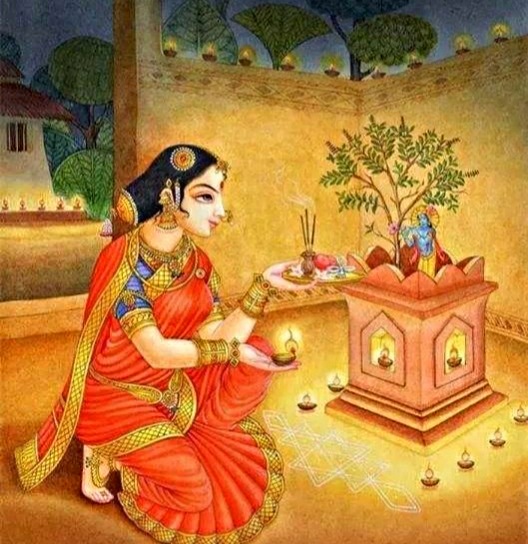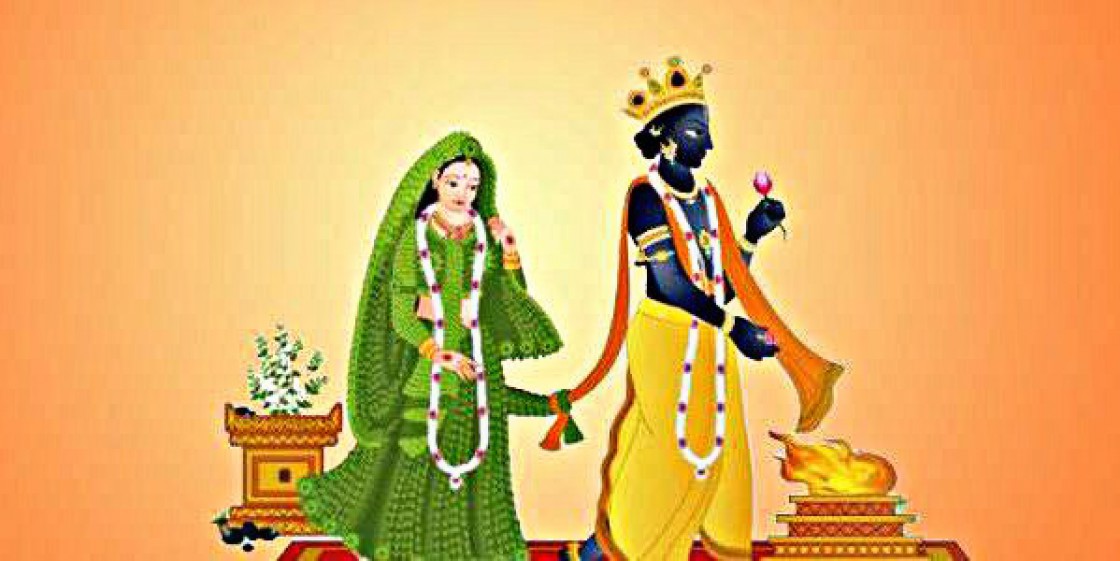With so much historic significance & use in everyday life, it’s not a surprise that the humble Tulasi (basil) plant has its very own festival. Tulasi Vivah (तुलसी विवाहः) is a very special kind of festival, one like no other. A spiritual marriage ceremony can be witnessed on this day. Tulasi Vivah (तुलसी विवाहः) is the festival of marriage of holy Tulasi (basil) plant & Lord Vishnu i.e., Shaligram (शालिग्रामः) (a stone form of Lord Vishnu). According to the Hindu Calendar, this festival is performed between 11th day of bright fortnight of Kartik month (कार्तिकः शुक्लपक्षे एकादशी) i.e., Prabodhini Ekadashi till, full moon day of bright fortnight of Kartika month (कार्तिकः शुक्लपक्षे पूर्णिमा) which is also known as Tulasi Vivah Purnima. However, in many parts of India, the festival is celebrated only on 11th or till 12th day only.
Tulasi Vivah (तुलसी विवाहः) is a ceremonial festival where the marriage ceremony of Shaligram (शालिग्रामः) (Lord Vishnu) & Goddess Tulasi is performed by the devotees. This festival marks the end of monsoon season & the beginning of winter season. This marriage ritual is performed in the evening. This ceremonial festival is the beginning of auspicious rituals, marriages, etc. in Hinduism. A day prior to the Vivah (विवाहः) (marriage), the planter of Tulasi (basil) plant (a special structure in which the Holy basil plant is grown) is painted & decorated. Some flowers are offered to the plant, tamarind & Indian gooseberry (amla) are offered. Lord Vishnu’s Shaligram & Goddess Tulasi are also worshipped a day before marriage by chanting Stotras, Shlokas, Bhajans, etc. which makes the ambience more lively, festive & spiritual.
Following are some shlokas to praise & worship Lord Vishnu & Goddess Tulasi;
सशङ्खचक्रं सकिरीटकुण्डलं
सपीतवस्त्रं सरसीरुहेक्षणम्।
सहारवक्षःस्थलकौस्तुभश्रियं
नमामि विष्णुं शिरसा चतुर्भुजम्॥
Meaning- The one who is carrying a disk & conch in his hand, who is wearing yellow clothes, adorned with a crown & earrings, who has lotus like eyes, who is wearing Kaustubh gem near his heart, I bow down to that four handed Lord Vishnu.
शुक्लाम्बरधरं विष्णुं शशिवर्णं चतुर्भुजम् ।
प्रसन्नवदनं ध्यायेत् सर्वविघ्नोपशान्तये ॥
Meaning- Who is wearing white clothes, who is All-Pervading, who is bright in appearance like the Moon & who have four arms, who have a delightful & pleasant face; let us meditate on Him to ward of all obstacles.
नमामि शिरसा देवीं तुलसीं विलसत्तनुम् ।
यां दृष्ट्वा पापिनो मर्त्या मुच्यन्ते सर्वकिल्बिषात् ॥
Meaning – I respectfully bow down to Goddess Tulasi, the foremost among the Goddesses & who has a shining form, with her sight only the sinners of this mortal world become free from all Sins.
तुलस्या रक्षितं सर्वं जगदेतच्चराचरम् ।
या विनिहन्ति पापानि दृष्ट्वा वा पापिभिर्नरैः ॥
Meaning – Goddess Tulasi protects everyone, the movable & immovable beings, & She destroys the Sins of sinful persons, once they see Her & surrender to Her with devotion.

Historical account of the Tulasi Vivah (तुलसी विवाहः) –
According to the Shiva Purana, there was a demon named Dambh, he was the devotee of Lord Vishnu. He started doing penance for the attainment of the son. After many years Lord Vishnu got pleased with his penance & appeared in front of Dambh & stated to ask for his desired boon. Dambh gets very pleased with the sight of Lord Vishnu & after paying homage he asks for the son, who becomes Lord Vishnu’s devotee, most intelligent, powerful & skilful. The son, who wins all the three worlds (स्वर्गः, पृथ्वी & पातालः) & the gods would never be able to defeat him. Lord Vishnu offered his desired boon. After few years Dambh’s wife delivers a very lustrous son & they kept his name Shankhacuda. Throughout his childhood, he obtains all kinds of knowledge. Later, when he enters into his youth, he went to the Pushkar & started his penance to please Lord Brahma. After prolonged penance, Lord Brahma got pleased with his penance & told him to ask for a boon. After paying homage to Lord Brahma, Shankhacuda asks that, he never gets defeated by any God, to this Lord Brahma agrees & offers him the boon & told him to go to the Badri forest where he will find a girl named Vrunda, who is the daughter of Dharmadhvaj, performing her penance, meet her & marry that girl.
Later, Shankhacuda went to the Badri forest & met Vrunda & told her about himself, his boon & Lord Brahma’s demand of marrying her. She agrees to it & both of them gets married. Later, Shankhacuda becomes the king of the demons & wins all the three worlds. After few years, gods went to Lord Brahma & Lord Vishnu & complained about Shankhacuda, to this Lord Vishnu said that, only Lord Shiva can advise & help about this problem. After reaching to Lord Shiva & requesting for help, he said that he will proceed for a war with Shankhacuda to conquer heaven & earth back with the help of all the gods & goddesses. After prolonged war, no one was able to defeat Shankhacuda as he was wearing Lord Vishnu’s armour & his wife Vrunda was the chaste wife & she had a boon that no one can kill his husband until she is the chaste wife.
So, to break both the boon, first Lord Vishnu took the form of an old man & went to Shankhacuda & asked him for his armour in charity as he was best known for the charity. Shankhacuda gave him his armour. Later Lord Vishnu took the form of Shankhacuda & went to his palace stating that he won the battle. Vrunda gets very joyful to see his husband back from long battle & thus, Lord Vishnu successfully breaks Vrunda’s chastity. On the other side Lord Shiva kills Shankhacuda with his trident & from Shankhacuda’s bones forms lustrous conch (शंखः). When Vrunda realizes that this is not Shankhacuda but someone else in the form of Shankhacuda she gets angry & curses Lord Vishnu that he will become a stone & he will get away from his wife Goddess Lakshmi. Knowing this, Lord Shiva appears before Vrunda & told her not to get angry & asks her to leave this gross body which will be converted into the sacred river called Gandaki & she will get a celestial body & she will be worshipped like a Goddess in the form of a Tulasi plant & once in a year the stone form of Lord Vishnu (शालिग्रामः) will marry the Tulasi plant. She will be dear to Lord Vishnu & not even a single worship of Lord Vishnu will be complete without Tulasi leaves. Thus, Tulasi is very sacred for Hindus & she is worshiped as a goddess. Till date this Shaligram (शालिग्रामः) stones (a stone form of Lord Vishnu) are only found on the bank of the river Gandaki. This is the reason every year Tulasi Vivah (तुलसी विवाहः) is held with the form of Lord Vishnu.

Ritual Ceremony of Tulasi Vivah (तुलसी विवाहः) –
The ceremony of Tulasi Vivah (तुलसी विवाहः) begins with bathing a Tulasi plant & Lord Vishnu’s Shaligram. The Tulasi plant is decorated like a bride with a red saree, jewellery & bindi. Lord Vishnu’s Shaligram is dressed in dhoti & jewellery. The puja area is decorated with rangoli. The whole Tulasi plantner is dressed up like a bride who’s ready to get married. To begin with the preparation of the mandap, four sugarcanes or banana tree leaves are kept on the four sides. A two sitting place is arranged where the right one is covered with red cloth & the left one with yellow cloth. Then the Tulasi plant is placed on the right sitting place & the Shaligram of Lord Vishnu on the left.
Then the Kalash filled with water is installed by adding some raw rice, some mango leaves are arranged in the water above which a coconut tied with red thread is placed. After that, an idol of Lord Ganesha is worshipped by doing Panchopchar Pujan (पञ्च उपचारः) [they are; Applying fragrant powder (गंधः), Offering Flowers (पुष्पम्), Burning Extruded incense (धूपः), Lighting the Lamp (दीपः), Offering Food (नैवेद्यम्)]. Later, white powder (अबिलम्), turmeric powder (हरिद्रा), red turmeric powder (कुंकुमः), etc are offered to Lord Vishnu & Goddess Tulasi. Chunri & shringar samagri is offered to Goddess Tulasi after which the garland is offered to Goddess Tulasi after touching Lord Vishnu’s Shaligram & another garland is offered to Lord Vishnu after touching the Tulasi plant with it. A thread is then tied to link the couple. For the Kanyadaan, some raw ice & dakshina (i.e., 51rs or more) is kept in the palm & then offered to Lord Vishnu. Later, red turmeric powder (कुंकुमः) & Mangalsutra is offered to Goddess Tulasi.
For the Gathbandhan, one should take the red chunri & white silk cloth, fill some raw rice & tie both the cloth together in a knot. The white side is kept around Lord Vishnu's Shaligram (शालिग्रामः) & the red side on the Tulsi plant. After this, the circumambulation of Tulasi plant is done by holding Shaligram (शालिग्रामः) in the hand. At the end, food is offered (नैवेद्यम्) to Lord Vishnu & Goddess Tulasi followed by waving the lamps (आरार्तिकम्) to Lord Vishnu & Goddess Tulasi. The whole ritual of Tulasi Vivah (तुलसी विवाहः) is completed after this. Devotees present at the wedding, shower red turmeric powder (कुंकुमः) & rice on the couple. Tulasi Vivah (तुलसी विवाहः) can be celebrated either in temples or at home.
Thus, this is the most special & important festival in Hinduism as from this day the beginning of the marriage season & all the auspicious rituals are performed. A huge celebration is done from Prabodhini Ekadashi till Purnima, each house & each temple celebrates this marriage ceremony with full enthusiasm. The whole city is decorated with lights & lamps, just like Diwali. As this festival holds vital part in Hinduism, these 5 days are also known & celebrated as Dev Diwali i.e., the festival of lights of Gods & Goddesses (देवस्य दीपावली) in HInduism.
श्रावणः शुक्लपक्षे ० १,२०७७
